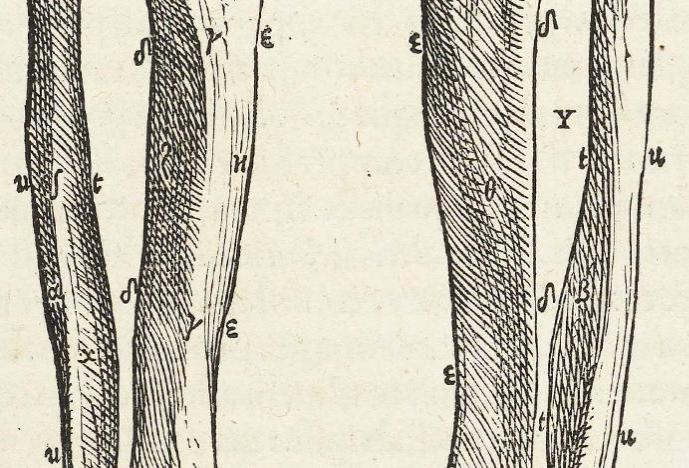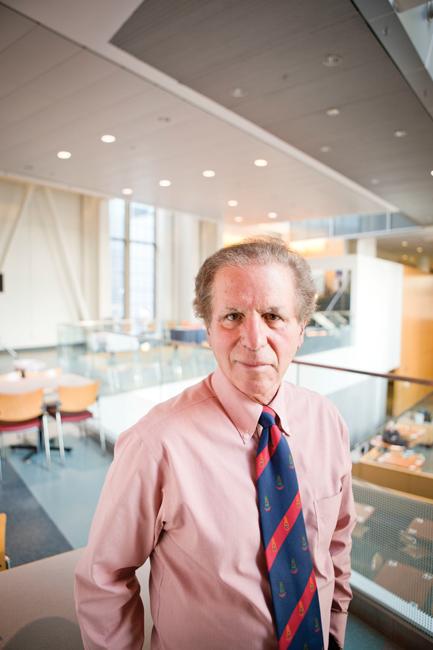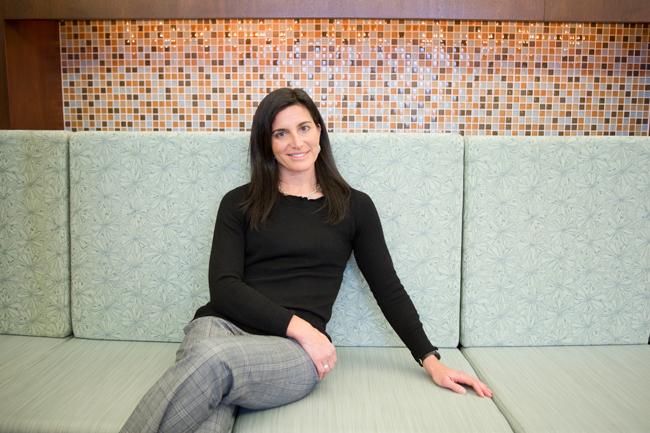Structural Elements
Orthopedists tap improved imaging, bioregeneration, and less-invasive surgeries to help athletes mend
- Feature

Drawing of leg bones, 16th century
A young woman lies anesthetized on the operating table. Sterile blue drapes expose her left knee, tea-stained with antiseptic and swollen with saline.
A few weeks ago while running across a soccer field, she planted her cleat in the turf to change direction. Her knee twisted, and, with a pop, her anterior cruciate ligament tore. At that moment, she became one of the estimated 150,000 people in this country each year who rupture an ACL.
On this wintry day, Elizabeth Matzkin, an HMS assistant professor of orthopedic surgery and surgical director of women’s musculoskeletal health at Brigham and Women’s Hospital, is surgically reconstructing this patient’s torn ACL. Through one of two small holes bracketing the kneecap, Matzkin has inserted a slim tubular camera, an arthroscope, that is transmitting images of her movements inside the joint to a monitor mounted above the table. Through the other opening, Matzkin wields a succession of slender instruments that click, whirr, and whine. Separately, she snips free a pair of hamstring tendons and sews them together to make a new ligament.
Matzkin divides her attention between the knee and the monitor. Nudging a drill into place, she prepares a small pilot hole, then bores a tunnel for the new ligament, first through the femur, then through the tibia. She threads in the new ACL and fixes it in place at both ends.
“Women tend to have smaller femurs than men. This technique allows me to ensure I have a long enough tunnel for the new ligament,” says Matzkin. The minimally invasive technique produces smaller scars and may also allow for a speedier recovery than traditional surgery—this young woman could be scoring goals again within a year.
Tactical Changes
A future version of this procedure may be quite different. In that reality, Matzkin no longer needs to repurpose a hamstring tendon; her colleague has used the patient’s own stem cells to grow a new ACL. Matzkin also no longer worries about her patient developing arthritis. Scientists have figured out how to preserve cartilage and prevent joints from degenerating. And Matzkin no longer sees this injury more frequently in women than in men. After researchers discovered why female athletes tore their ACL two to eight times more often than male athletes—and disproportionately suffered certain other physical injuries—athletes and trainers used that new knowledge to close the gender gap through education and prevention.
According to Jesse Jupiter, HMS Hansjörg Wyss AO Professor of Orthopedic Surgery at Massachusetts General Hospital, studies are underway in each of these areas. In the laboratory, researchers are growing tendons from stem or tendon cells. Surgeons have begun to transfer cartilage cells from inside a knee or an ankle to parts of a joint that have lost their gliding cushion.

“Thirty years ago, football players who tore their knees needed open surgery,” says Jupiter. “Those guys now have permanent disabilities. Today, we not only can repair torn tissue and cartilage, we’ve got office arthroscopy with local anesthesia that provides a quick sense of what’s going on in the joint.”
Minimally invasive techniques continue to be game changers in sports medicine. Rather than making a wide incision to insert a plate and screws to stabilize a cyclist’s broken collarbone, surgeons can now insert a metal rod through a small opening. Doctors are using ultrasound probes to stimulate tendon healing in patients with tennis elbow, thus offering treatment that’s less aggressive than standard injection techniques.
Improved imaging helps, too. Enhancements in diagnostic imaging mean that orthopedists can quickly receive images pinpointing the location and detailing the extent of an injury. Researchers are assessing new magnetic resonance techniques to uncover spinal conditions, peer inside joints, and measure tissue stiffness at trigger points, the painful spots of hyperirritated muscle that arise from trauma-induced musculoskeletal stress. Musculoskeletal ultrasound offers a new way to diagnose injuries and to study changes in inflammation or blood flow immediately after an activity.
Real-time imaging allows physicians to see whether they’re targeting the right spot during treatment. Rosalyn Nguyen, an HMS instructor in the Department of Physical Medicine and Rehabilitation at Mass General and Spaulding Rehabilitation Hospital, is using ultrasound to guide injections given to alleviate joint pain. She says the exceptional level of control she gets by holding the ultrasound wand in one hand, watching the screen, and manipulating the syringe in her other hand is worth the years it can take to master the technique.
“It helps me improve accuracy and therefore efficacy, especially for patients who haven’t responded to previous injections,” she says.
The Next Generation
Advances are not found only in the clinic and the surgical theater. Research has shown that athletes at all levels can lessen both the likelihood and severity of injury by staying fit, even in the off-season. And athletes and their trainers are analyzing and optimizing the biomechanics behind certain sports—how a golfer swings or a how a pitcher throws a softball—to avoid overuse injury or prevent reinjury.

Even with improvements like these, many people with sports-related injuries to their bones, muscles, tendons, or ligaments don’t heal as well as they could. For them, hope lies in the burgeoning field of bioregenerative medicine. In this discipline, researchers are developing ways to replace or regrow damaged tissues by stimulating the body’s natural healing abilities.
One technique that has generated interest is the injection of fluids to stimulate healing. This may involve the use of platelet-rich plasma, or PRP, filtered from the injured athlete’s blood. Another approach, known as proliferative injection therapy or prolotherapy, calls for the injection of a mild irritant, such as a dextrose solution, to stimulate healing.
“It’s like recruiting the patient’s warrior cells to an area,” says Nguyen, who performs both procedures. “They marshal other cells to the region and take the patient through the stages of the healing cascade: inflammation, proliferation, remodeling.”
Clinical trials are underway, and early research suggests that PRP and prolotherapy reduce pain and hasten recovery in athletes with certain tendon, ligament, and joint injuries—including rotator cuff tendinopathy, tennis elbow, and plantar fasciitis—who have not responded to other treatments or who want to avoid surgery.
New techniques being explored by Jupiter and other researchers involve using an athlete’s mesenchymal stem cells—young cells that can become a variety of cell types, including bone, cartilage, or fat—to mend broken bones, restore arthritic joints, or grow new ligaments.
Currently, 5 to 10 percent of patients have fractures that fail to knit back together in under nine months. For those patients, physicians rely on scaffolds, bone grafts, cement, and other mechanical remedies. Jupiter believes that adding mesenchymal stem cells to those techniques might help stimulate the blood flow and bone growth necessary for healing.
He imagines one day implanting a tube seeded with stem cells and growth factors into the injured area, triggering the body to make its own new bone, or elastic ligament, or gliding cartilage.
The X Factor
Not all advances are technological. Some involve understanding the needs of special populations.
Although 42 years have passed since Title IX ushered in a flood of female athletes at colleges and universities, there are still gaps in our understanding of the extent to which women’s injuries differ in location, frequency, presentation, and severity from those of men in the same sport. Journals teem with studies attempting to identify the components: When is anatomy to blame, like women’s smaller ACL notches, wider pelvises, or more “knock-kneed” stance? What roles do hormones play in collagen, bone, and ligament characteristics? Does strength and movement training reduce injury? The answer to the last one, happily, appears to be “yes.”

As director of the Women’s Sports Medicine Program at Brigham and Women’s, as well as physician to several national and collegiate women’s sports teams, Matzkin has a front-row seat to the factors that affect female athletes. Chief among them is a cluster of interrelated conditions known as the female athlete triad. First defined in 1992, it consists of poor nutrition, menstrual irregularities, and low bone density. Women with the triad fall along a spectrum of not eating three balanced meals a day to full-blown anorexia or bulimia.
“The resulting low energy balance throws off their systems so they don’t get their menstrual cycles regularly,” Matzkin says. “That’s bad for the bone health of young women—particularly since they’re at the age when the bone density they build is all they’re going to have for the rest of their lives.”
Other researchers have focused on women who are pregnant and who want to continue to be physically active. In the past few decades, studies have demonstrated the health benefits and low risks of physical activity for both mother and fetus, convincing orthopedists to encourage moderate, noncontact exercise during and after pregnancy. Specific guidance is taking shape for gestational diabetes and high blood pressure.
Back in Play
Orthopedists who specialize in sports medicine tend to share certain characteristics with their patients: They love sports, they’re team players, and they want to perform to the best of their ability. They also value a level playing field.
For Matzkin, Nguyen, and Jupiter, a six-year-old who falls while ice skating receives the same care as a shortstop who sprains an ankle in a playoff game. The professional athlete simply comes with a larger crowd—coach, trainer, agent, media, fans—whose pressures a doctor must weigh against the medical evidence of the player’s recovery.
“My patient may be a celebrity, but he’s also somebody’s son,” says Jupiter, who last year performed multiple arm surgeries on New England Patriots’ tight end Rob Gronkowski. “I want to treat him as responsibly as if he were my son.”
And like parents, orthopedists take pride in seeing their patients get back in the game.
“As a surgeon, I love operating. But more than that, I love seeing patients return to what they want to do when they’re recovered,” says Matzkin, pointing to postcards and newspaper clippings sent by former patients eager to share their varsity game scores or snapshots of them hitting the slopes again. “Working with athletes is great. They’re very motivated to get back to being active.”
As children engage in single sports more intensely and older adults become more active, as women and men of all ages commit to club sports and recreational activities with as much passion as professional athletes, orthopedists who seek out and apply the latest advances will continue to serve as invaluable members of the team.
Stephanie Dutchen is a science writer in the HMS Office of Communications and External Relations.
Images: Wellcome Library, London (top); John Shares (portraits)